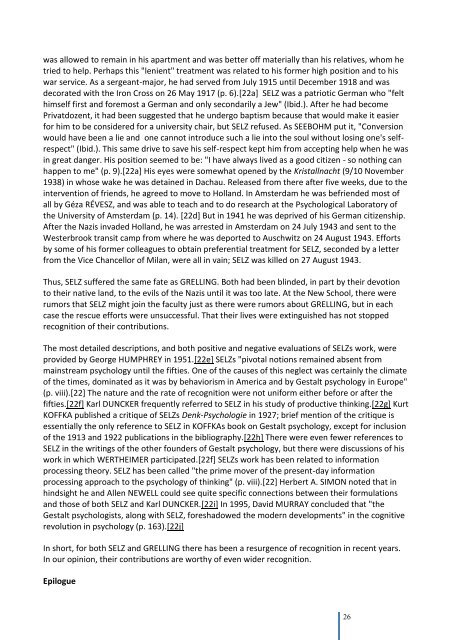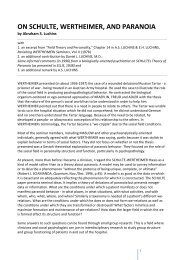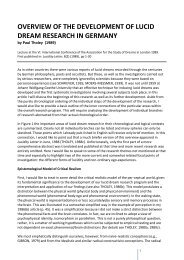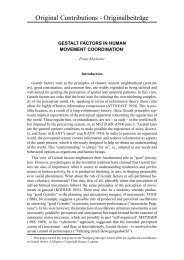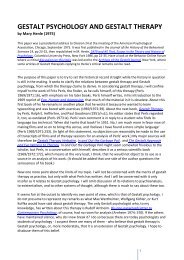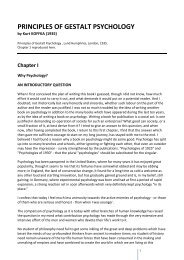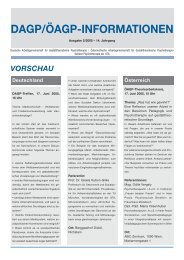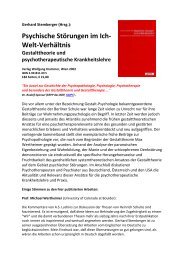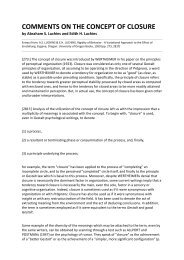pdf-Download - Society for Gestalt Theory and its Applications (GTA)
pdf-Download - Society for Gestalt Theory and its Applications (GTA)
pdf-Download - Society for Gestalt Theory and its Applications (GTA)
You also want an ePaper? Increase the reach of your titles
YUMPU automatically turns print PDFs into web optimized ePapers that Google loves.
was allowed to remain in his apartment <strong>and</strong> was better off materially than his relatives, whom he<br />
tried to help. Perhaps this "lenient" treatment was related to his <strong>for</strong>mer high position <strong>and</strong> to his<br />
war service. As a sergeant-major, he had served from July 1915 until December 1918 <strong>and</strong> was<br />
decorated with the Iron Cross on 26 May 1917 (p. 6).[22a] SELZ was a patriotic German who "felt<br />
himself first <strong>and</strong> <strong>for</strong>emost a German <strong>and</strong> only secondarily a Jew" (Ibid.). After he had become<br />
Privatdozent, it had been suggested that he undergo baptism because that would make it easier<br />
<strong>for</strong> him to be considered <strong>for</strong> a university chair, but SELZ refused. As SEEBOHM put it, "Conversion<br />
would have been a lie <strong>and</strong> one cannot introduce such a lie into the soul without losing one's selfrespect"<br />
(Ibid.). This same drive to save his self-respect kept him from accepting help when he was<br />
in great danger. His position seemed to be: "I have always lived as a good citizen - so nothing can<br />
happen to me" (p. 9).[22a] His eyes were somewhat opened by the Kristallnacht (9/10 November<br />
1938) in whose wake he was detained in Dachau. Released from there after five weeks, due to the<br />
intervention of friends, he agreed to move to Holl<strong>and</strong>. In Amsterdam he was befriended most of<br />
all by Géza RÉVESZ, <strong>and</strong> was able to teach <strong>and</strong> to do research at the Psychological Laboratory of<br />
the University of Amsterdam (p. 14). [22d] But in 1941 he was deprived of his German citizenship.<br />
After the Nazis invaded Holl<strong>and</strong>, he was arrested in Amsterdam on 24 July 1943 <strong>and</strong> sent to the<br />
Westerbrook transit camp from where he was deported to Auschwitz on 24 August 1943. Ef<strong>for</strong>ts<br />
by some of his <strong>for</strong>mer colleagues to obtain preferential treatment <strong>for</strong> SELZ, seconded by a letter<br />
from the Vice Chancellor of Milan, were all in vain; SELZ was killed on 27 August 1943.<br />
Thus, SELZ suffered the same fate as GRELLING. Both had been blinded, in part by their devotion<br />
to their native l<strong>and</strong>, to the evils of the Nazis until it was too late. At the New School, there were<br />
rumors that SELZ might join the faculty just as there were rumors about GRELLING, but in each<br />
case the rescue ef<strong>for</strong>ts were unsuccessful. That their lives were extinguished has not stopped<br />
recognition of their contributions.<br />
The most detailed descriptions, <strong>and</strong> both positive <strong>and</strong> negative evaluations of SELZs work, were<br />
provided by George HUMPHREY in 1951.[22e] SELZs "pivotal notions remained absent from<br />
mainstream psychology until the fifties. One of the causes of this neglect was certainly the climate<br />
of the times, dominated as it was by behaviorism in America <strong>and</strong> by <strong>Gestalt</strong> psychology in Europe"<br />
(p. viii).[22] The nature <strong>and</strong> the rate of recognition were not uni<strong>for</strong>m either be<strong>for</strong>e or after the<br />
fifties.[22f] Karl DUNCKER frequently referred to SELZ in his study of productive thinking.[22g] Kurt<br />
KOFFKA published a critique of SELZs Denk-Psychologie in 1927; brief mention of the critique is<br />
essentially the only reference to SELZ in KOFFKAs book on <strong>Gestalt</strong> psychology, except <strong>for</strong> inclusion<br />
of the 1913 <strong>and</strong> 1922 publications in the bibliography.[22h] There were even fewer references to<br />
SELZ in the writings of the other founders of <strong>Gestalt</strong> psychology, but there were discussions of his<br />
work in which WERTHEIMER participated.[22f] SELZs work has been related to in<strong>for</strong>mation<br />
processing theory. SELZ has been called "the prime mover of the present-day in<strong>for</strong>mation<br />
processing approach to the psychology of thinking" (p. viii).[22] Herbert A. SIMON noted that in<br />
hindsight he <strong>and</strong> Allen NEWELL could see quite specific connections between their <strong>for</strong>mulations<br />
<strong>and</strong> those of both SELZ <strong>and</strong> Karl DUNCKER.[22i] In 1995, David MURRAY concluded that "the<br />
<strong>Gestalt</strong> psychologists, along with SELZ, <strong>for</strong>eshadowed the modern developments" in the cognitive<br />
revolution in psychology (p. 163).[22j]<br />
In short, <strong>for</strong> both SELZ <strong>and</strong> GRELLING there has been a resurgence of recognition in recent years.<br />
In our opinion, their contributions are worthy of even wider recognition.<br />
Epilogue<br />
26


